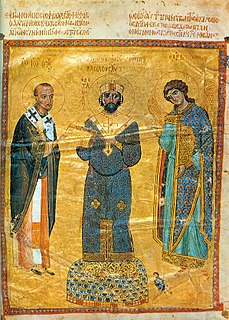The 1000s was a decade of the Julian Calendar which began on January 1, 1000, and ended on December 31, 1009.
The 970s decade ran from January 1, 970, to December 31, 979.
The 990s decade ran from January 1, 990, to December 31, 999.

Year 1057 (MLVII) was a common year starting on Wednesday of the Julian calendar.
Year 1001 (MI) was a common year starting on Wednesday of the Julian calendar. It is the first year of the 11th century and the 2nd millennium.

Year 1004 (MIV) was a leap year starting on Saturday of the Julian calendar.

Year 1078 (MLXXVIII) was a common year starting on Monday of the Julian calendar.

Year 992 (CMXCII) was a leap year starting on Friday of the Julian calendar.

Year 1030 (MXXX) was a common year starting on Thursday of the Julian calendar.

Year 997 (CMXCVII) was a common year starting on Friday of the Julian calendar.

Year 1056 (MLVI) was a leap year starting on Monday of the Julian calendar.

Between 780–1180, the Byzantine Empire and the Abbasid & Fatimid caliphates in the regions of Iraq, Palestine, Syria, Anatolia and Southern Italy fought a series of wars for supremacy in the Eastern Mediterranean. After a period of indecisive and slow border warfare, a string of almost unbroken Byzantine victories in the late 10th and early 11th centuries allowed three Byzantine Emperors, namely Nikephoros II Phokas, John I Tzimiskes and finally Basil II to recapture territory lost to the Muslim conquests in the 7th century Arab–Byzantine wars under the failing Heraclian Dynasty.
Damian Dalassenos was a Byzantine aristocrat and the first known member of the Dalassenos noble family. He is known for his service as the military governor (doux) of Antioch in 996–998. He fought the Fatimids with some success, until he was killed at the Battle of Apamea on 19 July 998.

The Battle of the Orontes was fought on 15 September 994 between the Byzantines and their Hamdanid allies under Michael Bourtzes against the forces of the Fatimid vizier of Damascus, the Turkish general Manjutakin. The battle was a Fatimid victory.

The Battle of Apamea was fought on 19 July 998 between the forces of the Byzantine Empire and the Fatimid Caliphate. The battle was part of a series of military confrontations between the two powers over control of northern Syria and the Hamdanid emirate of Aleppo. The Byzantine regional commander, Damian Dalassenos, had been besieging Apamea, until the arrival of the Fatimid relief army from Damascus, under Jaysh ibn Samsama. In the subsequent battle, the Byzantines were initially victorious, but a lone Kurdish rider managed to kill Dalassenos, throwing the Byzantine army into panic. The fleeing Byzantines were then pursued, with much loss of life, by the Fatimid troops. This defeat forced the Byzantine emperor Basil II to personally campaign in the region the next year, and was followed in 1001 by the conclusion of a ten-year truce between the two states.

Constantine Dalassenos was a prominent Byzantine aristocrat of the first half of the 11th century. An experienced and popular general, he came close to ascending the imperial throne by marriage to the porphyrogenita Empress Zoe in 1028. He accompanied the man Zoe did marry, Emperor Romanos III Argyros, on campaign and was blamed by some chroniclers for Romanos' humiliating defeat at the Battle of Azaz.
Abu Muhammad Lu'lu', surnamed al-Kabir and al-Jarrahi al-Sayfi, was a military slave (ghulam) of the Hamdanid Emirate of Aleppo. Under the rule of Sa'd al-Dawla, he rose to become the emirate's chamberlain, and on Sa'd al-Dawla's death in 991 he was appointed guardian of his son and successor, Sa'id al-Dawla. The able Lu'lu' soon became the de facto ruler of the emirate, securing his position by marrying his daughter to the young emir. His perseverance and aid from the Byzantine emperor Basil II preserved Aleppo from repeated Fatimid attempts to conquer it. Upon Sa'id al-Dawla's death in 1002—possibly poisoned by Lu'lu'—he became the ruler of the emirate, disinheriting Sa'id al-Dawla's sons. He ruled with wisdom until his death in 1008/9. He was succeeded by his son, Mansur, who managed to retain the throne until deposed in 1015/16.
Abu'l-Fada'il Sa'id al-Dawla was the third Hamdanid ruler of the Emirate of Aleppo. He succeeded his father Sa'd al-Dawla in 991, but throughout his reign real power rested in the hands of Sa'd al-Dawla's former chamberlain, Lu'lu', to whose daughter Sa'id was wed. His reign was dominated by the Fatimid Caliphate's repeated attempts to conquer Aleppo, which was prevented only by the intervention of the Byzantine Empire. Warfare lasted until 1000, when a peace treaty was concluded guaranteeing Aleppo's continued existence as a buffer state between the two powers. Finally, in January 1002 Sa'id al-Dawla died, possibly poisoned by Lu'lu', and Lu'lu' assumed control of Aleppo in his own name.
Theophylact Dalassenos was a Byzantine aristocrat who occupied a series of senior military positions in the 11th century.

The siege of Aleppo was a siege of the Hamdanid capital Aleppo by the army of the Fatimid Caliphate under Manjutakin from the spring of 994 to April 995. Manjutakin laid siege to the city over the winter, while the population of Aleppo starved and suffered from disease. In the spring of 995, the emir of Aleppo appealed for help from Byzantine emperor Basil II. The arrival of a Byzantine relief army under the emperor in April 995 compelled the Fatimid forces to give up the siege and retreat south.











